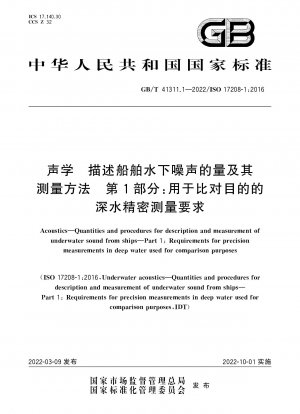GB/T 41311.1-2022
Acoustics—Quantities and procedures for description and measurement of underwater sound from ships—Part 1: Requirements for precision measurements in deep water used for comparison purposes (English Version)
- Standard No.
- GB/T 41311.1-2022
- Language
- Chinese, Available in English version
- Release Date
- 2022
- Published By
- 国家市场监督管理总局、中国国家标准化管理委员会
- Latest
- GB/T 41311.1-2022
- Scope
- This document specifies the general measurement system, measurement procedures and measurement methods for underwater radiated noise measurements of ships under specified operating conditions. This document does not prescribe or provide guidance on limits for underwater noise, nor does it address the potential effects of underwater noise on marine life. The results of the measured values are given in root mean square sound pressure level (SPL), therefore, the sound pressure level or SPL measured in the underwater far field of the ship can be equivalently used, and after being normalized to a distance of 1m, 1/3 Measurement results given by octave bandwidth (see 4.3). In this document, these measurements are expressed as "radiated noise level". Sound pressure levels are measured in the geometric far field and then normalized to a distance of 1 m for comparison with corresponding underwater noise limits. This document is applicable to the measurement of underwater radiated noise of various manned or unmanned ships on the surface of the sea, but not for submarines or aircraft. The measurement method has no fixed limit on the size of the ship, but requires the ship's sailing speed not to exceed 25.7 m/s (ie 50kn). The measurement method smoothes the Lloyd's image interference effect, but it does not eliminate the influence of propagation effects such as bottom reflection, seawater refraction and absorption. For these effects, this document does not give specific calculation corrections. This document does not require a fixed measurement location, but puts forward specific requirements for the selection of the measurement location. Intended uses of the method described in this document are: comparison with contractual limit requirements, comparison of ships of the same type, evaluation of spectral characteristics, and research and development. Potential users include government agencies, operators of scientific research vessels and owners of commercial vessels. Using data obtained from this measurement method to determine ship source levels for far-field noise forecasting, such as is required for most environmental impact studies or for creating underwater noise contour maps, requires additional post-processing.
GB/T 41311.1-2022 Referenced Document
- IEC 60565 Underwater acoustics - Hydrophones - Calibration in the frequency range 0,01 Hz to 1 MHz
- ISO 18405 Underwater acoustics - Terminology
GB/T 41311.1-2022 history
- 2022 GB/T 41311.1-2022 Acoustics—Quantities and procedures for description and measurement of underwater sound from ships—Part 1: Requirements for precision measurements in deep water used for comparison purposes
